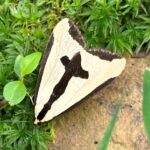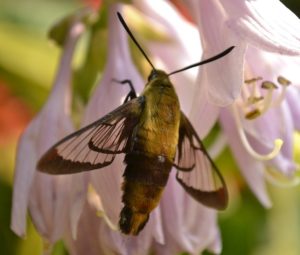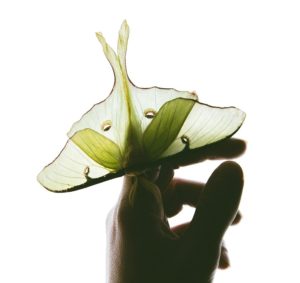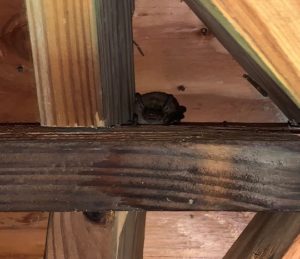Hello, fellow readers, We’ve chatted about how moths are like butterflies that party at night, a sentiment shared by Randi Eckel of Toadshade Wildflower Farm (link to the story below). Since then, I’ve grown far fonder of them; like butterflies, moths are beautiful too.
 A daily routine in recent weeks is gathering moths that have taken up residence on the screened porch overnight. They’re easy to capture by morning, sliding them into a container, barely waking them until releasing them outside. Curt jokes that I’m gathering the same ones each day. Maybe so, but it brings the question—why are moths attracted to lights and coming indoors? A subject we discussed with Blaine Rothauser last week in Keeping Lighting Pollinator-Friendly.
A daily routine in recent weeks is gathering moths that have taken up residence on the screened porch overnight. They’re easy to capture by morning, sliding them into a container, barely waking them until releasing them outside. Curt jokes that I’m gathering the same ones each day. Maybe so, but it brings the question—why are moths attracted to lights and coming indoors? A subject we discussed with Blaine Rothauser last week in Keeping Lighting Pollinator-Friendly.
My porch moths bring back a childhood memory.
I’ll admit their party has lessened the desire for porch camps on the futon, having them land in my hair. It reminds me of growing up when we’d vie for a position on the cots outside the tent during vacations. It was pitched as a treat, though the truth is we didn’t all fit inside. I woke to my mom’s “psst” sound to chase a raccoon sitting on my stomach eating undercooked green beans left from dinner. Another time, I woke to the tickling sensation of daddy-long leggers crawling across my lips. I still adore camping.
There are far more species of moths than butterflies
Over 160,000 moth species live worldwide compared to 17,500 butterflies, and 11,000 kinds of moths are in the United States. Most moths are nocturnal, active at night, and butterflies by day are called diurnal. Both are essential pollinators.

Clymene moth (Haploa Clymene)
Moths are chubbier, and the scales on their wings sluff off easier than butterflies, hence the powdery debris when you touch them. Their wings are flat on the body when resting, unlike butterflies that hold them tightly upright. Then, skippers in the family of butterflies have their wings at different angles when sleeping.
People don’t consider most moths beautiful. Other than, say, the Luna moth (Actias Luna), with its four to seven-inch lime green wingspan and stealth markings that look like eyes baffling bats—one of their greatest predators. Then there are Hummingbird Moths (Hemaris spp.), also called Clearwing Moths, that look like hummingbirds. There are many other beautiful moths, too, such as the Clymene Moth (Haploa clymene), also known as the Blessing Moth I came upon not long ago (link to story below).
Mystery of moths’ attraction to light

Hummingbird Moth Photo by Susan Holt Simpson on Unsplash
Though there have been numerous studies, it’s a mystery why moths are attracted to artificial light, especially ultraviolet (UV) bulbs. Most critters that fly keep the light sky above them rather than fly upside down. Nocturnal insects use the moon and stars’ light to navigate flight, and artificial lights confuse them. So, it’s not that they are attracted to it; they are disoriented, causing a sensory overload. They circle the bulb until they need to rest, finding a spot like the inside of my screened porch.
Folks create traps under lights, taking advantage of the moth’s confusion. But please don’t kill them. Moths, just like butterflies, surpass other insects as critical food for birds and other animals.
Moths don’t eat clothing, despite rumors. Their larvae (caterpillars) do, should a momma moth find animal fibers such as wool, cashmere, silk, angora, or even leather. They seek food for their babies with keratin, the same proteins found in hair and skin—why my diligence to keep them outside.
Mothballs are a deterrent, but they’re almost a hundred percent made of a pesticide called para-dichlorobenzene or PDCB. Rather than mothballs, cedar-lined closets and trunks or cedar blocks serve as a natural pest repellent.
What moths and bats have in common
Speaking of mothballs, they also deter bats, I learned during Curt’s DIY attempts to keep the resident bat from hunkering down in the barn. He made clever use of my pantyhose worn long ago in the corporate days. They made ideal casings for the hanging arsenal of deterrents, along with shiny throwaway pie plates. The strategy wasn’t effective until he added a fan, adding movement to the decorations. It was hilarious. The lone bat may be the same little fellow that hung on the barn door until, tumbling down stunned, he finally moved on.
“I feel a little sad,” Curt said. “I became attached to the little guy.”
While bats and many moths are considered ugly compared to butterflies, it brings an interesting thought. That beauty depends on things labeled as ugly, an irony of opposites. Yet, they serve magical and critical functions in the garden of life—a beautiful thing.
Garden Dilemmas? AskMaryStone@gmail.com (and your favorite Podcast App.)
There’s more to the story in the Garden Dilemmas Podcast:
A Garden Purpose for Pantyhose: You can cut them up and use them to tie back plants. I know it’s not that attractive, but they’re flexible, and when tied discreetly, the earth-tone ones aren’t bad. It’s soft on the wood and herbaceous plant stems. So, there you go. Another use for your pantyhose that we don’t wear anymore. Thank goodness, right?
Link to the Native Plants, especially Oaks, are Essential story featuring Randi Eckel of Toadshade Wildflower Farm.
Keeping Lighting Pollinator-Friendly with Blaine Rothauser.





Wonderful picture of the Luna Moth. Never seen it or read about it before. It’s a timely post you have as I returned home one day and found loads of moths inside my home by the entry running havoc on my rug. Not happy. I had to get rid of them using some essential lavender and vinegar and the hoover. Don’t mind them in the garden but not inside the home as I suspect the ones I found were the type that eat on textile fibres.
It’s wise to release the moths outside when you can. Or turn off the lights they are attracted to to keep them out. Indeed, they can’t live in the house as their larvae feed on textiles. Not the moths. Thanks for reading the post :^), Mary